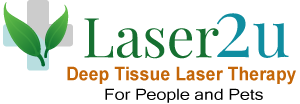
Jaw and TMJ Pain Dysfunction Relief using Deep Tissue Laser Therapy… New Advanced Approach to a Difficult Condition
Laser pain therapy VS. typical pain relief
For those who are currently experiencing TMD, there are several treatment methods available. Some such typical treatments are pain killers, dental splints, injections, massages, physical therapy, chiropractic or anti-inflammatory medications.
Unfortunately these therapies work for some but don’t always resolve all the various form of TMJ pain for everyone, even after months and years of various treatment forms. This is because these therapies are not very successful to restore complete joint function or completely address soft tissue issues.
Deep Tissue Laser therapy for pain can help TMD patients not only by restoring the muscular balance, but address the soft tissue issue, but also help healing the nerves surrounding the disk. Laser therapy can send blood and stimulated cells to the affected areas so that the muscles and other parts get enough energy to heal themselves.
Understanding Jaw and TMJ Pain
The Temporomandibular Joint (TMJ) Disorder typically cause several problems such as jaw pain, jaw lock, jaw popping, and jaw clicking. TMJ is the joint of the jaw and connects the lower jawbone or mandible to the upper temporal bone which is part of the cranium (skull).
Though pain or dysfunction of the temporomandibular joint is typically referred to as “TMJ”, it is just the name of the joint. The actual term for these symptoms is Temporomandibular Joint Disorder (or dysfunction). TMD is the abbreviated form of Temporomandibular Joint Disorder.
The Causes of TMD
It’s true that scientists do not know the actual causes of TMJ Disorder though they assume that a female hormone may be the cause since females are more affected than men. In some cases, trauma and development factors are typically the initial factors of TMD. There is a soft cushion or disc between the ball and socket of your joint. If arthritis starts developing in the disk, you will be affected by more serious conditions.
There is a popular belief that a bad bite or orthodontic braces can trigger TMJ disorders while others say rheumatic disease, such as arthritis, may also be the cause. But this theory is disputed by the researchers and is of course not proven.
TMJ Pain Disorder symptoms
Women suffer from TMJ problem more than men. It is more common in people between the ages of 20 and 40. Patients may be affected more seriously when they wake up. An affected person may have one or more of these following conditions at the same time.
- In your jaw joint area or the muscles of mastication, you will feel pain and tenderness on palpation. You will not only feel pain just in front of the ear but also in other situations such as chewing, clenching or yawning. The pain can be dull, aching, intermittent or even constant but rarely severe.
- Eating and even talking become difficult because mandibular movement becomes limited. Affected person cannot normally eat or talk because stiffness occurs in the jaw muscles and the joints. Less or more of the jaw locking is also possible.
- Clicking, popping, or crepitus (grating) noise is created during mandibular movement. The noise may be intermittent though.
- Other less common symptoms are – (a) pain or tenderness in the face, teeth, neck and shoulders (b) headache (c) hearing loss (d) dizziness (e) blinking (f) a sense that the teeth do not meet together properly and (g) pain or feeling of pressure behind the eyes.
TMD can be a chronic problem
The typical treatment for pain such as massages and physical therapy try to send blood to the affected areas and rely on available paths to send blood. If adequate amount of blood can be sent, the muscles and other affected parts will get energy and be healed. But TMD complications often block blood sending to the affected areas. So, typical therapies are often not very effective.
Laser treatment for pain has been so advanced that it is possible to restore the disk and tissue health using this technology. Though high power lasers often have high penetration and dosage capabilities, it does not mean it will hurt or burn. The therapist does not need to cut any part of your body. This is safe when a trained therapist delivers deep tissue laser therapy.
See Laser treatment’s medical success records in TMJ Disorder
Why will you not use deep tissue laser therapy if it is so successful to heal TMJ Disorder? We can help you with our valuable complimentary consult and guidance.
